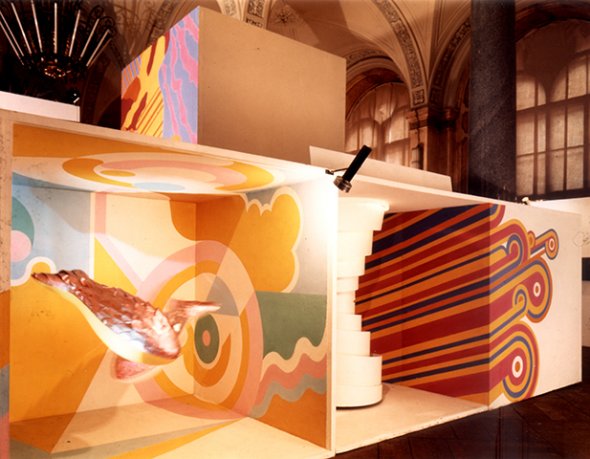Celebrations – design and interiors exhibition
The ninth Young Artists’ Exhibition was devoted to the fiftieth anniversary of the foundation of the USSR and presented a wide-ranging program. An exhibition of paintings, graphics, and sculptures was held in the Foreign Art Museum, while the Stock Exchange hosted the experimental collective interior design exhibition “Celebrations.” This latter event was one of most capacious presentations of contemporary art, which demonstrated that the avant-garde was not based just in alternative circles, but, through peculiarities of the Soviet system, it was also part of the official, politically acceptable process.
The exhibition’s title was open to various interpretations, and its formal alignment with the anniversary of the USSR, as well as its designation in the design category, made it possible to present a broad, atypically Soviet range of works, with much less painting and sculpture. It was “a dynamic exhibition-show and improvisation in which everything pulsed, moved, glittered, beeped, or revealed other dynamic-kinetic expressions.”[1] Viewers were surprised by the moving floor that beeped when walked upon, the “thirsty” silver fishes that moved in the air against the background of a sunny Pop-art painting, rotating cylinders and towers, etc.
The exhibition emphasized formal and aesthetic solutions, but it also paved the way for the hybrid and art-synthesis processes of the 1970s. Involving spatial, architectural, urban-planning, psychological, and other elements, it changed the way of art perception and the role of the audience.
An interview with J. Borgs in April, 2009.
Date: February 1972
Location: Exhibition hall of the Institute of Scientific Technical Information and Propaganda (the historic Stock Exchange), Riga.
Participants: Exhibition installer and chief artist: Jānis Pipurs. Creative team: Jānis Borgs, Nora Ķivule, Jānis Osis, Leo Preiss, Laimonis Šēnbergs, and Viesturs Vilks. Altogether forty-nine artists took part.


